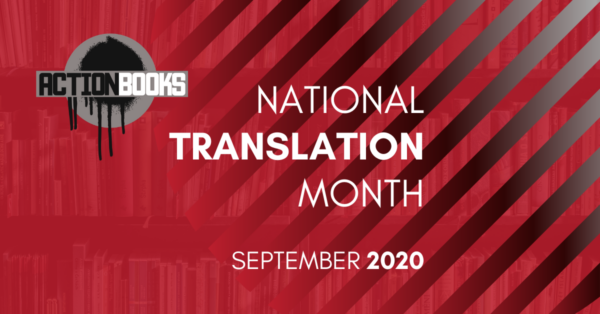
*
In a recent interview with the online poetry journal Buenos Aires Poetry, Víctor Rodríguez Núñez, a contemporary Cuban poet whom I have extensively translated into English, states the following:
Traces of Latin American poetry in North American poetry are almost imperceptible. Sometimes you might see a subtle nod to Vallejo, Neruda, perhaps Borges, but nothing more than that. The poets of the North have turned their backs on us, and this isn’t just something happening now, it’s been that way always. But even if they don’t know us, we know them, and that gives us the advantage.* (my translation)
Rodríguez Núñez concludes such ignorance on the part of “the poets of the North” is intrinsically tied to the lack of poetry in translation in the U.S.
The division between the North and the South that Rodríguez Núñez notes brings me immediately to what another Cuban poet wrote almost 130 years earlier with regard to that same divide. Nuestra América [Our America] by José Martí (1853-1895) highlights similar tensions on the continent. In this seminal and still incredibly relevant essay, written in 1891 in the U.S. (which Martí termed “the belly of the beast”), he warns Latin American intellectuals of the encroaching neo-colonialist and imperialist power of a country that had often served as a political model for 19th Century Latin American independence movements. In opposition to it, and in a genius decolonizing move, he proposes a strategic positionality for those intellectuals squarely in “Our América,” the title itself a subtle critique of the U.S.’s racist usurping of an entire continent’s name. This positionality calls for the rejection of foreign influence and a privileging of the autochthonous. Just as important, the essay serves to remind intellectuals that thought is activism; that contemplation, often considered to be passive, is actually vital to this struggle: “we must have no other pillow but our weapons—weapons of the mind, which vanquish all others. Fortifications built of ideas are more valuable than those built of stone.” *
I have chosen to highlight the viewpoints of these two Cuban thinkers because they are ones I return to quite often as I consider my work as a translator of Spanish American poetry into English. On the one hand, Rodríguez Núñez elaborates on the current situation of Spanish American poetry in translation today in the U.S. (and Spanish American Studies more broadly) as a reaffirmation of the continued imperialist and neo-colonialist notion of the U.S. as center and the unidirectional circulation of ideas from North to South back to North again –if it’s deemed necessary by the North– that such a notion implies. On the other, Martí offers me as a literary translator a way to respond to this situation through the possibility of strategic positionality as well as the recognition of my intellectual labor as a valid form of activism.
**
I’ll begin by giving you a brief explanation of the current situation of Spanish American poetry in translation in the U.S. I am aware I speak from a relative point of privilege with regard to what gets translated and what doesn’t get translated, as Spanish-language writing holds a special place in contemporary publication of translation. Though, as anyone who translates knows, the numbers are incredibly dismal across the board: roughly 0.7% of all titles published here in a given year are literary translation. For literature in Spanish, the 2019 numbers were, according to the Three Percent Database, 21 books of poetry versus 64 books of prose.
As for poetry in Spanish in English translation and published in the U.S., there are two main trends. The first has its beginnings in the sixties, when poets like Robert Bly, W.S. Merwin, and James Wright, among others, began translating and publishing Spanish-language poets. None of this is coincidence, of course. We can consider the translation “boom” of that moment as a response to what these poets considered to be a stale, conventional, formalist poetry in the U.S., bereft of emotion and political commitment (the Cuban Revolution, which triumphed in 1959, also played a role in turning eyes toward the region). Yes, in part. Ultimately, though, the phenomenon is intimately tied to the way a U.S. poetry audience thinks poets in Spanish should write and how such writing can benefit that audience. From the so-called boom there are two who remain continuously in print and with numerous translations: the Chilean Nobel Prize Winner Pablo Neruda and the Spanish poet and playwright, Federico García Lorca. While they have areas of their work that are undoubtedly avant-garde, much of what they are known for in English translation is, on the one hand, some sort of innate connection to sensuality, passion, feeling, emotion, and the body that “Americans” don’t have or have lost. On the other, their political commitment (and that of poets writing in Spanish more generally) has been over-emphasized in simplistic and obvious ways. In other words, the canonization of these two poets is an exotifying move, highlighting the racist, neo-colonialist trope of a U.S. reader, weary of the hardships of a developed (capitalist, imperialist) country drawn to a more “primitive,” passionate art. Bly called it hot Surrealism, a not-so-shocking tone-deaf misnomer. (See Jonathan Mayhew’s 2009 Apocryphal Lorca for an excellent discussion of all this). In any case, my point is that the fashioning of the Spanish-language poetry in English translation canon highlights work that is not necessarily complex, cerebral, or intellectual. We return to a typical colonialist/neo-colonialist dichotomy (as well as a gendered one): South equals sensual and irrational, an exotic land of corruption, dictators, and guerrillas; North equals cerebral and theoretical, a land of democracy and freedom, and more specifically, freedom of expression. Indeed, this erasure of Spanish as intellectual and difficult mimics the general trend in the U.S. of considering Spanish a “practical” and “easier” language (read what “the help” speaks, what poor people speak, what a newly discovered group of consumers speaks) when compared to traditionally “harder” languages, like French or German.
The second (and more recent) trend would seem to counter the one described above. Independent poetry presses over the past 15 years have sought out Spanish American poets who fall under the umbrella term of marginalized voices, in a move that echoes the very popular and successful trend in the U.S. of poetry based on identity politics. In their search to discover the underrepresented, small presses end up proposing –though albeit different– a just as limiting canon, handpicking poets who, in terms of content, often conveniently mirror back to a woke U.S. readership their own concerns and anxieties about representation, and, in terms of form, either privilege a direct, conversational tone, easily consumable (and translatable) or a so-called experimental aesthetic, also based on a mirroring back of U.S.-based definitions of what formal experimentation entails. One unexpected consequence of such a shift is that, in an effort to get their work published in English translation, some young Spanish American poets have begun to alter their poetics to accommodate the tastes of the hip U.S. poetry consumer.
What is unsettling to me in both cases is the question of positionality. Ultimately, the main purpose of such endeavors is what we, positioned in the U.S., can “get out” of Spanish American poetry. It serves our needs, whether it be a reaction to what’s going on in the U.S. literary world, or as a way to brand a certain kind of poetry wokeness, and yet the subtle cultural superiority behind such curation goes unchecked. In my view, this kind of a setup is just one more example of the unidirectional circulation between center and periphery.
***
As a translator I must recognize my positionality, both the aspects of it that are problematic and its potential for subversiveness. It is clear to me that I am in a privileged position, being based in the U.S., indirectly benefiting from its neo-colonialist, imperialist, racist policies and actions. I am, too, a specialist in Spanish American poetry. I received my doctorate from a Hispanic Literatures Department, rather than English, Comparative Literature, or Creative Writing Departments; this gives me a different perspective than many literary translators from Spanish into English. Much of the impetus behind why I translate has to do with reading and knowing Spanish American poetry, the work of many poets who are well-known in the region, and being shocked to find out it is not translated into English. While a part of my approach is based on what might be considered as offering up a counter-canon, I’m more invested in creating an alternative to any canon, be it in the U.S. or Spanish America. I make choices based on this. And the idea of choice, though seemingly obvious, is at the heart of strategic positionality. In my case, this means intentionally choosing poets whose work falls both outside the confines of what a U.S. reader might think a poet in Spanish “should” write like, as well as what Spanish American poetic canons have established as representative for their own readership.
In this way, I attempt to respond to a unidirectional U.S.-centric circulation of ideas, and second, to challenge the Spanish American poetry canon itself by working to bring poets who should be better known in Spanish to an English-reading audience. I’m constantly reminded that establishment literary culture in the U.S., despite its current claims of and calls for diversity, inclusion, progressiveness, is still fiercely and unabashedly English-only (we don’t need anything else, we have enough in our own language) as well as firmly rooted in the discourse and practice of policing citizenship (consider how many awards require U.S. residency as part of the eligibility requirements). The dismal numbers of literary translations shout out to us. But there are whispers too, like not referencing translators in reviews of translation or not naming the translator on social media (still happening ALL THE TIME). And then there are all out silences, which, due to questions of space, I won’t go into here.
It is precisely because of these challenges that we as literary translators must consider our positionality strategically, just as we must consider our labor our activism, our weapon, Martí’s weapons of the mind, if you will. Ultimately, for me to do so as a translator of Spanish American poetry is to attempt to be a part of a multidirectional circulation of ideas, an exchange, a dialectical relationship; a move in solidarity with the critique voiced by Rodríguez Núñez at the beginning of this essay. It is opting to help build fortifications, to help dig trenches in “Nuestra América.”
_________________________________
An earlier version of this brief essay was presented at the conference “Translation Across Disciplines,” Brown University, February 27-28, 2020.
* https://buenosairespoetry.com/2020/01/22/los-poetas-del-norte-nos-dieron-la-espalda-entrevista-con-victor-rodriguez-nunez/ Accessed 1/22/2020.
* José Martí. “Our America,” translated by Esther Allen. http://www.josemarti.cu/publicacion/nuestra-america-version-ingles/ Accessed 2/12/2020.

Katherine M. Hedeen is a translator, literary critic, and essayist. A specialist in Latin American poetry, she has translated some of the most respected voices from the region. Her publications include book-length collections by Jorgenrique Adoum, Juan Bañuelos, Juan Calzadilla, Juan Gelman, Fayad Jamís, Hugo Mujica, José Emilio Pacheco, Víctor Rodríguez Núñez, and Ida Vitale, among many others. She is a recipient of two NEA Translation grants in the US and a PEN Translates award in the UK. She is a Managing Editor for Action Books and the Poetry in Translation Editor at the Kenyon Review. She resides in Ohio, where she is a Professor of Spanish at Kenyon College. More information at: www.katherinemhedeen.com